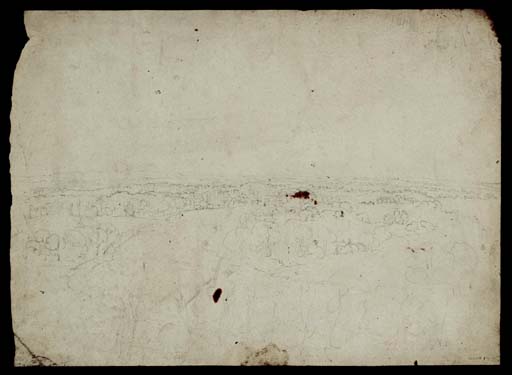Joseph Mallord William Turner Brocklesby: The Hall seen from the Mausoleum 1798
Image 1 of 2
Joseph Mallord William Turner,
Brocklesby: The Hall seen from the Mausoleum
1798
Joseph Mallord William Turner 1775–1851
Brocklesby: The Hall seen from the Mausoleum 1798
D05165
Turner Bequest LXXXIII 7
Turner Bequest LXXXIII 7
Pencil on white wove paper, 261 x 358 mm
Stamped in black ‘LXXXIII 7’ bottom right
Stamped in black ‘LXXXIII 7’ bottom right
Accepted by the nation as part of the Turner Bequest 1856
References
1909
A.J. Finberg, A Complete Inventory of the Drawings of the Turner Bequest, London 1909, vol.I, p.221, LXXXIII 7, as ‘Bend of river, with extensive view of flat country.’ c.1800–4.
Technique and condition
It appears that two different graphite pencils were used to draw this composition. The softer pencil (which gives a darker line) has been used in the middle-ground and background to add definition to several areas of the drawing, particularly foliage. The foreground, which is more loosely conceived than the rest of the image, has been sketched using a harder pencil which creates a paler, more delicate line. The same hard pencil was used to define the line of the distant hills. The sky has been left blank.
Both the recto and verso are covered with heavy surface dirt and many stains; however the drawing was been cleaned during conservation treatment to make it suitable for public display, because many of these marks are the result of Turner’s own handling and storage of the work, and they are evidence of its history. For example, there are fingerprint marks on the edges of the sheet where it has been turned by fingers stained with a brown, oil-based paint.
On the verso there are several patches of oil paint which have caused the prominent brown staining which is visible on the recto. There is also evidence of white, yellow and blue/green paints on the verso of the sheet. A prominent tide-line caused by water damage is noticeable along the entire left-hand side of the verso. The right-hand side of the verso has a layer of heavy, black surface dirt which appears to have been caused by the paper being scraped across a dirty surface, or possibly a floor or the ground.
Helen Evans
October 2008
Revised by Joyce Townsend
February 2011
How to cite
Helen Evans, 'Technique and Condition', October 2008, revised by Joyce Townsend, February 2011, in Andrew Wilton, ‘Brocklesby: The Hall seen from the Mausoleum 1798 by Joseph Mallord William Turner’, catalogue entry, March 2013, in David Blayney Brown (ed.), J.M.W. Turner: Sketchbooks, Drawings and Watercolours, Tate Research Publication, April 2015, https://wwwThis is a sheet from the Brocklesby Mausoleum sketchbook, of which seven pages survive, disbound; see under D05159 (Turner Bequest LXXXIII 1). Having made several drawings of the mausoleum at Brocklesby and its immediate surroundings, Turner drew a view here looking north over the estate towards the house, about a mile away, from the low hill on which the mausoleum is situated. The hill had been a Saxon burial site.
Verso:
Blank; splashed with oil paint and watercolour; stained and dirty; not stamped.
Andrew Wilton
March 2013
How to cite
Andrew Wilton, ‘Brocklesby: The Hall seen from the Mausoleum 1798 by Joseph Mallord William Turner’, catalogue entry, March 2013, in David Blayney Brown (ed.), J.M.W. Turner: Sketchbooks, Drawings and Watercolours, Tate Research Publication, April 2015, https://www


